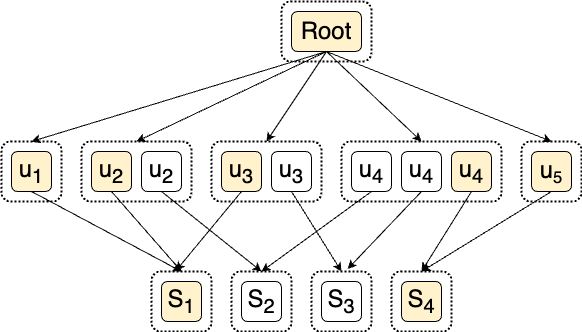
June 22, 2023
In this quick note, I will show that the E-graph extraction problem is NP-complete.
The E-graph extraction problem is defined as follows:
Input: An E-graph G and a cost function mapping E-nodes
to positive numbers.
Output: A DAG t represented by G such that t has the
lowest cost possible.First, the extraction problem is in NP1 because it can be reduced to integer linear programming (ILP). Moreover, we show the extraction problem is NP-hard by reducing the minimum set cover problem to it.
The minimum set cover problem is defined as follows (adapted from Wikipedia):
Input: A set of elements {1, 2, ..., n} (called the universe)
and a collection S of m sets whose union equals the
universe.
Output: The smallest sub-collection of S whose union equals
the universe. We show an instance of how this minimum set cover problem can be reduced to E-graph extraction: consider the universe \(U = \{1, 2, 3, 4, 5\}\) and the collection of sets \(S = \{ \{1, 2, 3\}, \{2, 4\}, \{3, 4\}, \{4, 5\} \}\). The smallest subset of \(S\) that covers all of the elements is { {1, 2, 3}, {4, 5} }.
Our construction is as follows:
This will produce the following E-graph for our example.

The intuition behind this construction is that, to extract the root E-class, we have to cover all the elements in the universe, so we need to pick an E-node from each \(c_{j}\). To cover all \(c_{j}\)’s with the smallest cost means picking as fewer \(S_i\) E-nodes as possible, which corresponds to a minimum set cover.
As a side note, the construction here uses function symbols with non-constant arities (i.e., the root E-node). This can be fixed by replacing the root E-node with \(O(n)\) many E-nodes with binary function symbols forming a depth \(O(\log n)\) binary tree, so our reduction only requires unary and binary function symbols.
Update (Aug 29, 2023): Michael Stepp showed the NP-completeness of this problem via a similar reduction to Min-SAT in his thesis.
Here we consider the optimization variant of the NP complexity class. The decision version of the extract problem is, given an E-graph and a cost function, does there exist a DAG represented by the E-graph with a given cost \(n\)?↩︎
In fact, the costs of the root E-node and \(u_{j_k}\)’s do not matter and can be set as zero, as these E-nodes will be in the extracted DAG anyway. We (arbitrarily) set their cost to be 1 (instead of say 0) to make sure the cost model is strictly monotonic.↩︎